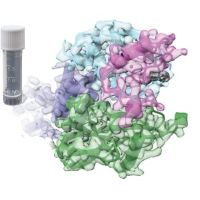Specification
| Description | Recombinant protein from the full-length sequence of Homo sapiens beta-secretase 2 (BACE2), transcript variant a (NM_012105). |
| Organism | Homo sapiens (Human) |
| Expression Host | Human Cells |
| Tag Info | His or DYKDDDDK. Please contact us if you need further information or require specific designed tag. |
| Purity | Greater than 90% by SDS-PAGE gel |
| Uniprot ID | Q9Y5Z0 |
| Entry Name | BACE2_HUMAN |
| Gene Names | BACE2 AEPLC ALP56 ASP21 CDA13 UNQ418/PRO852 |
| Alternative Gene Names | AEPLC ALP56 ASP21 |
| Alternative Protein Names | Beta-secretase 2 (EC 3.4.23.45) (Aspartic-like protease 56 kDa) (Aspartyl protease 1) (ASP1) (Asp 1) (Beta-site amyloid precursor protein cleaving enzyme 2) (Beta-site APP cleaving enzyme 2) (Down region aspartic protease) (DRAP) (Memapsin-1) (Membrane-associated aspartic protease 1) (Theta-secretase) |
| Application | Antigens, Western, ELISA and other in vitro binding or in vivo functional assays, and protein-protein interaction studies; For research & development use only! |
| Buffer | Purified protein formulated in a sterile solution of PBS buffer, pH7.2, without any preservatives |
| Endotoxin | Endotoxin level is < 0.1 ng/µg of protein (<1EU /µg) |
| Length | 518 |
| Molecular Weight(Da) | 56180 |
| Protein Sequence | (The sequence of expressed protein may have some variation from the sequence shown below. Please contact us for the exact sequence.) MGALARALLLPLLAQWLLRAAPELAPAPFTLPLRVAAATNRVVAPTPGPGTPAERHADGLALALEPALASPAGAANFLAMVDNLQGDSGRGYYLEMLIGTPPQKLQILVDTGSSNFAVAGTPHSYIDTYFDTERSSTYRSKGFDVTVKYTQGSWTGFVGEDLVTIPKGFNTSFLVNIATIFESENFFLPGIKWNGILGLAYATLAKPSSSLETFFDSLVTQANIPNVFSMQMCGAGLPVAGSGTNGGSLVLGGIEPSLYKGDIWYTPIKEEWYYQIEILKLEIGGQSLNLDCREYNADKAIVDSGTTLLRLPQKVFDAVVEAVARASLIPEFSDGFWTGSQLACWTNSETPWSYFPKISIYLRDENSSRSFRITILPQLYIQPMMGAGLNYECYRFGISPSTNALVIGATVMEGFYVIFDRAQKRVGFAASPCAEIAGAAVSEISGPFSTEDVASNCVPAQSLSEPILWIVSYALMSVCGAILLVLIVLLLLPFRCQRRPRDPEVVNDESSLVRHRWK |
Background
| Function | FUNCTION: Responsible for the proteolytic processing of the amyloid precursor protein (APP). Cleaves APP, between residues 690 and 691, leading to the generation and extracellular release of beta-cleaved soluble APP, and a corresponding cell-associated C-terminal fragment which is later released by gamma-secretase. It has also been shown that it can cleave APP between residues 671 and 672. Responsible also for the proteolytic processing of CLTRN in pancreatic beta cells (PubMed:21907142). {ECO:0000269|PubMed:10591213, ECO:0000269|PubMed:11083922, ECO:0000269|PubMed:11423558, ECO:0000269|PubMed:15857888, ECO:0000269|PubMed:16816112, ECO:0000269|PubMed:21907142}. |
| Pathway | |
| Protein Families | Peptidase A1 family |
| Tissue Specificity | Brain. Present in neurons within the hippocampus, frontal cortex and temporal cortex (at protein level). Expressed at low levels in most peripheral tissues and at higher levels in colon, kidney, pancreas, placenta, prostate, stomach and trachea. Expressed at low levels in the brain. Found in spinal cord, medulla oblongata, substantia nigra and locus coruleus. Expressed in the ductal epithelium of both normal and malignant prostate. {ECO:0000269|PubMed:10591213, ECO:0000269|PubMed:10677483, ECO:0000269|PubMed:10683441, ECO:0000269|PubMed:10749877, ECO:0000269|PubMed:10838186, ECO:0000269|PubMed:10965118, ECO:0000269|PubMed:11083922}. |
QC Data
| Note | Please contact us for QC Data |
| Product Image (Reference Only) |  |

